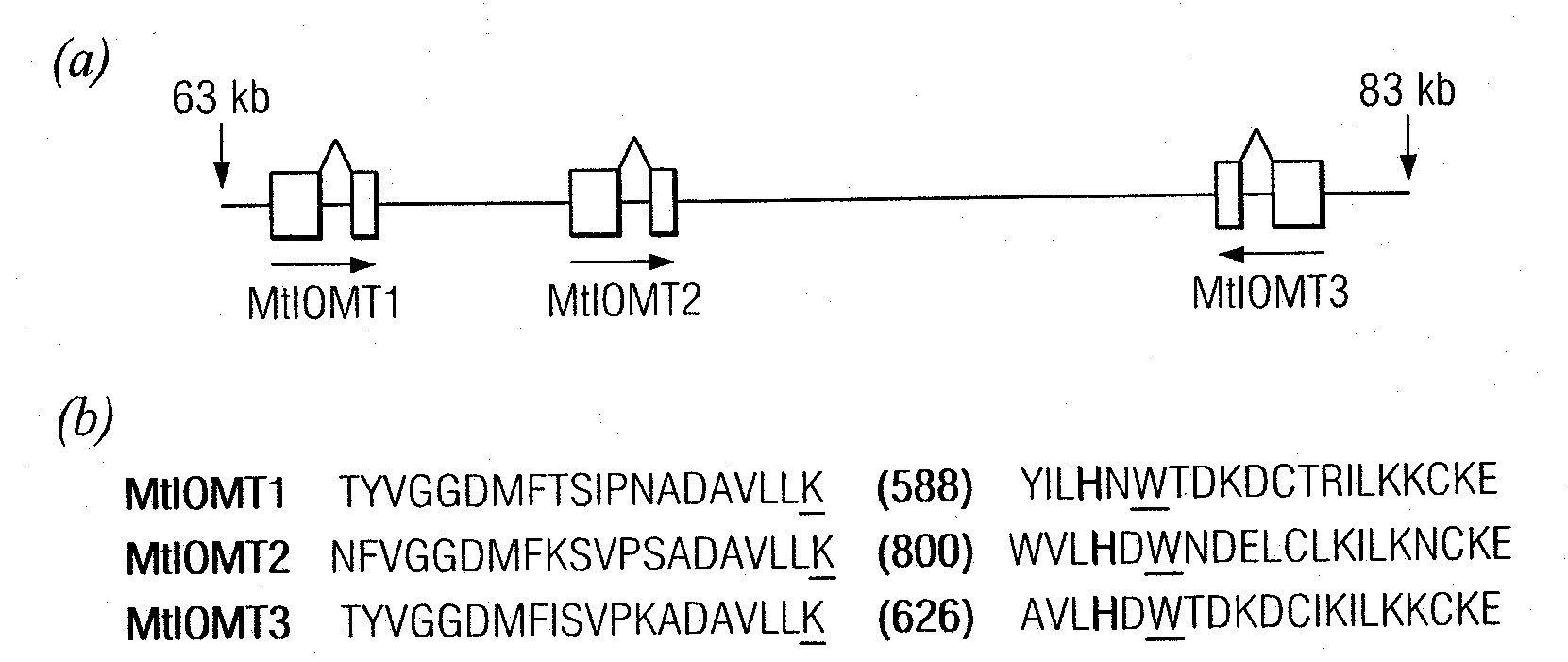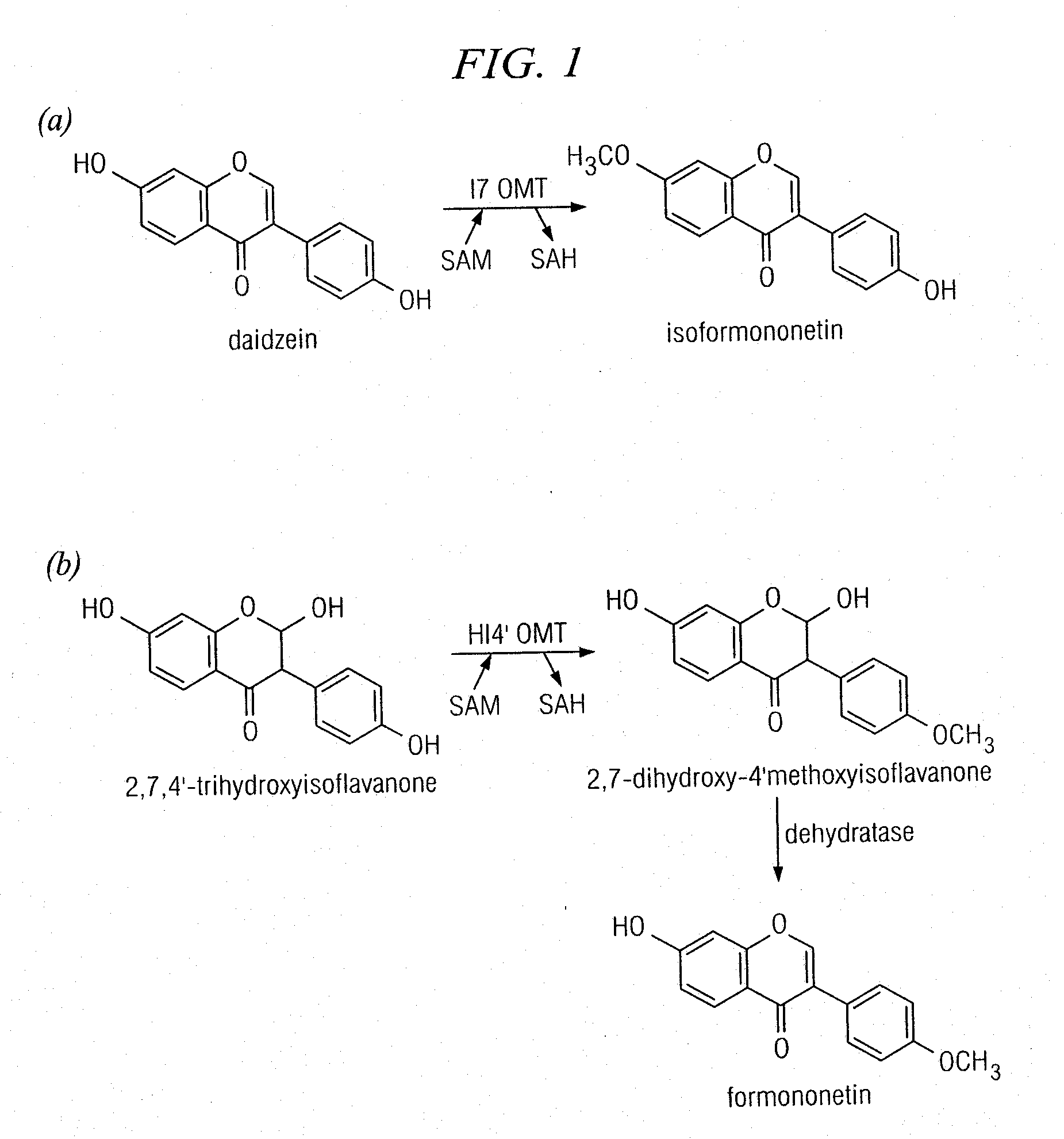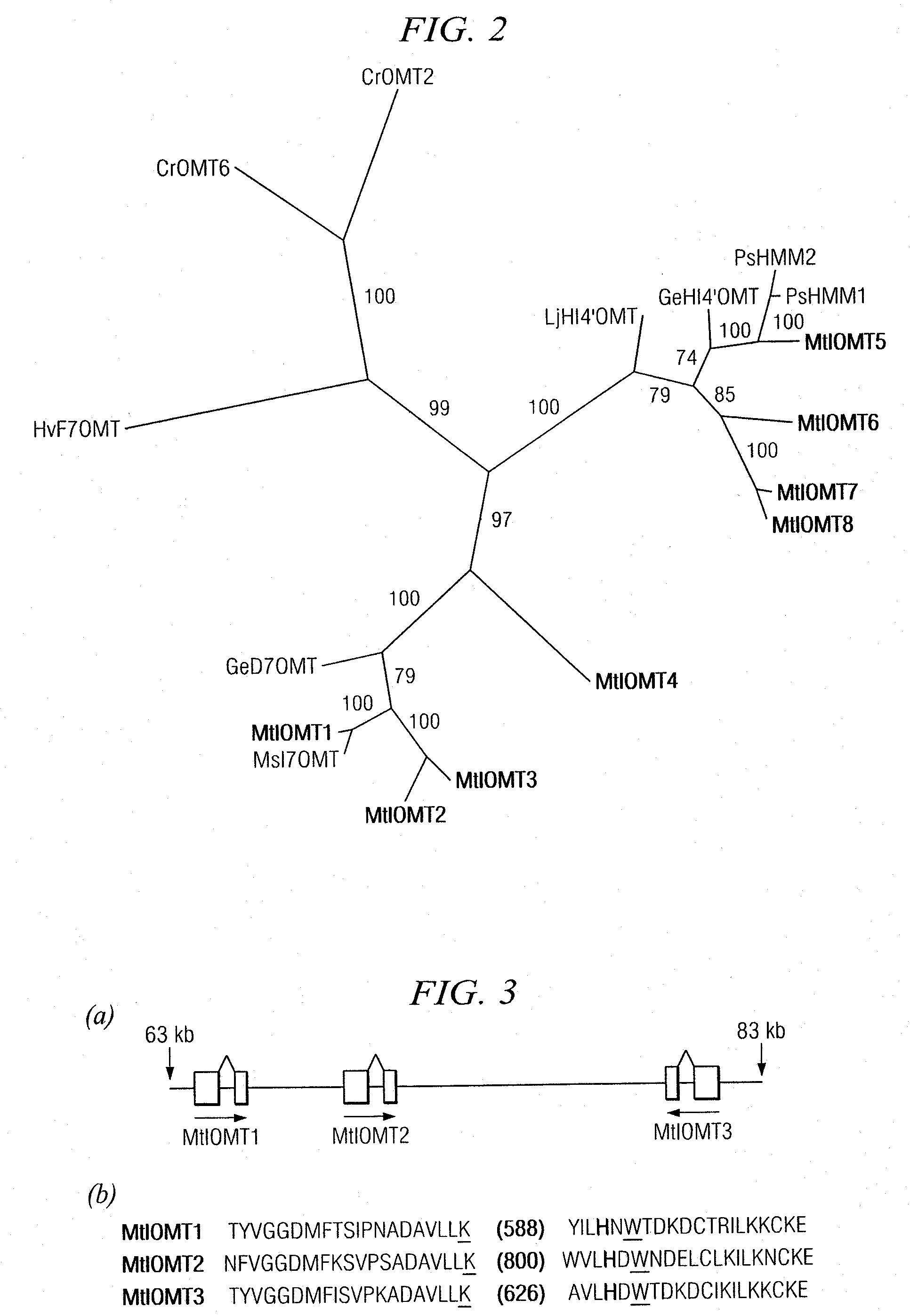Plant isoflavone and isoflavanone o-methyltransferase genes
a technology of isoflavone and isoflavanone, which is applied in the field of molecular biology, can solve the problems of lack of efficient modification methods of most secondary metabolites
- Summary
- Abstract
- Description
- Claims
- Application Information
AI Technical Summary
Benefits of technology
Problems solved by technology
Method used
Image
Examples
example 1
Cloning, Expression, and Purification of M. truncatula IOMTs
[0152]Candidate M. truncatula IOMTs were identified by searching MtGI Release 7.0 (May 1, 2003) (www.tigr.org / tigr-scripts / tgi / T_index.cgi?species=medicago) for ESTs with similarity to M. sativa I7OMT (GB accession number U97125) using BLAST searches. Full-length ESTs for MtIOMT1 (NF070A11EC1F1082) were obtained from an elicited M. truncatula cell culture library; full length MtIOMT3 ESTs (NF027F03PL1F1029) were obtained from a phosphate-starved leaf library; full length MtIOMT4 ESTs (N201058e) were obtained from a phosphate-starved root library; full length MtIOMT6 (NF031D06RT1F1046), MtIOMT7 (NF005H09RT1F1079), and MtIOMT8 ESTs (NF031H02RT1F1016) were obtained from a M. truncatula developing root library.
[0153]Cloning of MtIOMT5 (corresponding to TC 100926, TIGR MtGI v.8) was as described previously (Liu et al., 2005). To obtain a full-length cDNA for MtIOMT2, specific primers designed based upon the M. truncatula genomic...
example 2
OMT Assays
[0154]Reactions (200 μl) were performed in 0.1 M potassium phosphate, pH 7.4, 10% (w / v) sucrose, 14 mM β-mercaptoethanol with 10 μM protein, 0.5 mM S-adenosyl-L-methionine, and 80 μM phenolic substrates. All substrates were purchased from Indofine (Hillsborough, N.J.) except 6,7-dihydroxy-4′-methoxyisoflavone, dihydrodaidzein, and vestitol, which were purchased from Apin (Oxfordshire, UK). 2,7,4′-Trihydroxyisoflavanone was purified from IFS reactions carried out with liquiritigenin as described (Liu et al., 2005). OMT assays were incubated at 30° C. for 2 h and extracted with ethyl acetate. Ethyl acetate extracts were dried under N2 and the resultant material was resuspended in 50-100 μl of methanol. Samples were analyzed on an Agilent 1100 HPLC, equipped with a quaternary pump (model #G1311A), a degasser (model #G1322A), an autosampler (model #G1313A), and a diode array detector (model #G1315A). Samples of 20 μl were applied to an ODS2 reverse-phase column (5 μm particle ...
example 3
Tandem MS Analysis
[0156]An HP 1100 series II LC system (Hewlett-Packard, Palo Alto, Calif.) with a photodiode array detector was coupled to a Bruker Esquire ion-trap mass spectrometer (ITMS) equipped with an electrospray ionization source. A reverse phase, C18, 5 μm, 4.6×250 mm column (J. T. Baker, Phillipsburg, N.J.) was used for separations. The mobile phase consisted of 0.1% (v / v) acetic acid using linear gradients of 5-90% acetonitrile (v / v) in 70 min. The flow rate was 0.8 ml / min, and the temperature of the column was kept at 28° C. Both positive- and negative-ion mass spectra were acquired. Positive-ion ESI was performed using an ion source voltage of 4.0 KV and a capillary offset voltage of 86.0 V. Nebulization was aided with a coaxial nitrogen sheath gas provided at a pressure of 60 psi. Desolvation was aided using a counter current nitrogen flow set at a pressure of 12 psi and a capillary temperature of 300° C. Mass spectra were recorded over the range 50-2200 m / z. The ITMS...
PUM
| Property | Measurement | Unit |
|---|---|---|
| Temperature | aaaaa | aaaaa |
| Fraction | aaaaa | aaaaa |
| Molar density | aaaaa | aaaaa |
Abstract
Description
Claims
Application Information
 Login to View More
Login to View More - R&D
- Intellectual Property
- Life Sciences
- Materials
- Tech Scout
- Unparalleled Data Quality
- Higher Quality Content
- 60% Fewer Hallucinations
Browse by: Latest US Patents, China's latest patents, Technical Efficacy Thesaurus, Application Domain, Technology Topic, Popular Technical Reports.
© 2025 PatSnap. All rights reserved.Legal|Privacy policy|Modern Slavery Act Transparency Statement|Sitemap|About US| Contact US: help@patsnap.com



